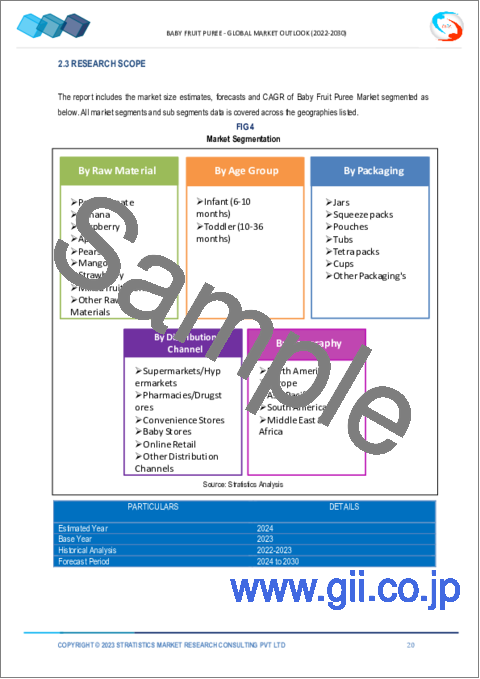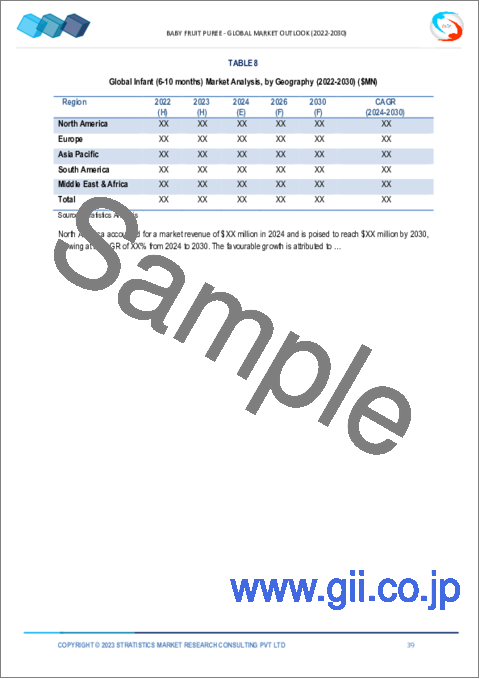|
|
市場調査レポート
商品コード
1453901
乳幼児用フルーツピューレの2030年までの市場予測:原材料、年齢層、包装、流通チャネル、地域別の世界分析Baby Fruit Puree Market Forecasts to 2030 - Global Analysis By Raw Material (Pomegranate, Banana, Raspberry, Apple, Pears, Mango, Strawberry, Mixed fruit blends and Other Raw Materials), Age Group, Packaging, Distribution Channel, and By Geography |
||||||
カスタマイズ可能
|
|||||||
| 乳幼児用フルーツピューレの2030年までの市場予測:原材料、年齢層、包装、流通チャネル、地域別の世界分析 |
|
出版日: 2024年03月03日
発行: Stratistics Market Research Consulting
ページ情報: 英文 200+ Pages
納期: 2~3営業日
|
全表示
- 概要
- 図表
- 目次
Stratistics MRCによると、乳幼児用フルーツピューレの世界市場は予測期間中にCAGR 5.5%で成長しています。
乳幼児用フルーツピューレは、フルーツをミキサーにかけたり潰したりして、固形食に移行する乳幼児に適した滑らかで柔らかい状態にした栄養価の高い食品です。通常、新鮮な果物の皮をむき、調理してからピューレ状にして、乳幼児が喉に詰まらせる危険性のある塊や繊維を取り除き、乳幼児の成長と発達に必要なビタミン、ミネラル、食物繊維が含まれています。ファーストフードとして生後4~6ヶ月の乳幼児に与えられることが多く、手作りでも市販のものでもよく、単一のフルーツピューレやさまざまなフルーツのブレンドなど、さまざまな選択肢があります。
製品の革新
メーカー各社は、乳幼児に多様な味覚体験を提供するため、さまざまな果物のブレンドを絶えず探求し、実験しています。これは、両親のさまざまな嗜好に対応し、乳幼児のために新しく刺激的な味を試してみたいという両親の興味を引くことで、事業拡大に貢献しています。さらに、より健康的で清潔な食品を求める需要の高まりを受けて、メーカーはオーガニック原料を使用し、人工添加物や保存料を避けることに注力しており、これが市場の成長を後押ししています。
高コスト
ベビー用フルーツピューレの価格が高いため、価格に敏感な消費者、特に低所得世帯や購買力の低い地域の消費者は敬遠する可能性があります。小売業者は高価格帯を消費者導入の障壁と認識し、他の低価格のベビーフードを優先する可能性があります。そのため、特に価格に敏感な市場では、ベビー用フルーツピューレ市場の成長の妨げになる可能性があります。
健康意識
親が子どもの栄養をより意識するようになるにつれて、フルーツピューレを含む健康的で栄養価の高い食品を乳幼児に与えようとする傾向が強まっています。これらの製品は、乳幼児の食生活にフルーツを取り入れるための便利で健康的な選択肢であり、さまざまな味や栄養素に早くから触れることを促進すると考えられています。さらに、こうした健康志向の高まりは、オーガニックや非遺伝子組み換え(遺伝子組み換え)の選択肢を重視することにもつながり、オーガニック・ベビー・フルーツピューレ製品に対する需要の高まりにつながっています。
教育不足
親はピューレを与える適切な年齢、適切な固さ、含まれる果物の種類を知らないことがあります。その結果、離乳食の開始が遅れたり、誤った与え方をしてしまったりします。伝統的な授乳方法に頼ったり、栄養価の低い代替品を選んだりすることもあります。さらに、教育不足はベビー・フルーツピューレに関する誤解や誤った情報につながり、市場の成長を徐々に妨げることになります。
COVID-19の影響
COVID-19の大流行はベビー・フルーツピューレ市場に大きな悪影響を及ぼし、業界のさまざまな側面に影響を与えました。パンデミックはサプライチェーンの混乱を招き、乳幼児用調製粉乳やその他の必要な乳幼児用品の入手に課題をもたらしました。その結果、家族が複数の店舗に足を運ばなければならず、売り切れ商品に遭遇し、出費がかさむことになった。さらに、必要な授乳サポートを受けられない家庭もあり、それがこの市場規模の妨げとなった。
予測期間中、テトラパック・セグメントが最大となる見込み
テトラパック・セグメントが最大のシェアを占めると推定されます。テトラパックは、カートンベースの容器で知られる包装の人気ブランドで、ジュース、ミルク、ピューレなどの液体や半液体の保存に広く使用されています。これらの容器は、親が乳幼児にミルクを与えるための便利で持ち運び可能な選択肢を提供し、鮮度を維持し、こぼれるのを防ぐリシーラブル機能を備えています。さらに、安全性を考慮して設計されていることが多く、中のピューレが汚染されることなく栄養価を維持できるため、このセグメントの拡大を後押ししています。
予測期間中、コンビニエンスストア分野のCAGRが最も高くなると予想されます。
コンビニエンスストアは、ベビー用フルーツピューレ製品に簡単にアクセスできるため、忙しい親が外出先でこれらの製品を便利に購入できることから、予測期間中にCAGRが最も高くなると予想されます。これらの店舗では通常、さまざまな年齢層や味の好みに合わせて、さまざまな乳幼児用フルーツピューレのオプションを提供しています。さらに、年齢層に合わせたベビー用フルーツピューレを在庫していることが多く、乳幼児に適した製品を確実に見つけることができるため、このセグメントの成長を大きく後押ししています。
最大のシェアを占める地域:
乳幼児に栄養価が高く健康的な食品を与えることの重要性に対する保護者の意識が高まっているためです。同市場では、乳幼児の味覚嗜好の変化に対応するため、さまざまな製品の革新や新しいフレーバーや組み合わせのイントロダクションが行われています。さらに、この地域では共働きの親が増加しており、便利で時間を節約できるベビーフードの需要が高まっています。
CAGRが最も高い地域:
消費者が消費する製品に含まれる成分に対する意識を高め、より健康的な代替品を求めるようになっているためである。この地域には、アマラ・ベビーフード、ダノン、ネスレなどの主要企業が進出しています。さらに、欧州地域にはスーパーマーケット、ハイパーマーケット、ベビー用品専門店などの小売インフラが確立されています。こうした流通チャネルは、乳幼児用フルーツピューレを消費者が容易に入手できるようにし、同地域の市場成長をさらに後押ししています。
無料カスタマイズサービス:
本レポートをご購読のお客様には、以下の無料カスタマイズオプションのいずれかをご利用いただけます:
- 企業プロファイル
- 追加市場プレーヤーの包括的プロファイリング(3社まで)
- 主要企業のSWOT分析(3社まで)
- 地域セグメンテーション
- 顧客の関心に応じた主要国の市場推計・予測・CAGR(注:フィージビリティチェックによる)
- 競合ベンチマーキング
- 製品ポートフォリオ、地理的プレゼンス、戦略的提携に基づく主要企業のベンチマーキング
目次
第1章 エグゼクティブサマリー
第2章 序文
- 概要
- ステークホルダー
- 調査範囲
- 調査手法
- データマイニング
- データ分析
- データ検証
- 調査アプローチ
- 調査ソース
- 1次調査ソース
- 2次調査ソース
- 前提条件
第3章 市場動向分析
- 促進要因
- 抑制要因
- 機会
- 脅威
- 新興市場
- 新型コロナウイルス感染症(COVID-19)の影響
第4章 ポーターのファイブフォース分析
- 供給企業の交渉力
- 買い手の交渉力
- 代替品の脅威
- 新規参入業者の脅威
- 競争企業間の敵対関係
第5章 世界の乳幼児用フルーツピューレ市場:原材料別
- ザクロ
- バナナ
- ラズベリー
- りんご
- 洋ナシ
- マンゴー
- いちご
- ミックスフルーツブレンド
- その他の原材料
第6章 世界の乳幼児用フルーツピューレ市場:年齢層別
- 幼児(6~10ヶ月)
- 幼児(10~36ヶ月)
第7章 世界の乳幼児用フルーツピューレ市場:包装別
- 瓶
- スクイーズパック
- パウチ
- タブ
- テトラパック
- カップ
- その他のパッケージ
第8章 世界の乳幼児用フルーツピューレ市場:流通チャネル別
- スーパーマーケット/ハイパーマーケット
- 薬局・ドラッグストア
- コンビニエンスストア
- ベビー用品店
- オンライン小売
- その他の流通チャネル
第9章 世界の乳幼児用フルーツピューレ市場:地域別
- 北米
- 米国
- カナダ
- メキシコ
- 欧州
- ドイツ
- 英国
- イタリア
- フランス
- スペイン
- その他欧州
- アジア太平洋地域
- 日本
- 中国
- インド
- オーストラリア
- ニュージーランド
- 韓国
- その他アジア太平洋地域
- 南米
- アルゼンチン
- ブラジル
- チリ
- その他南米
- 中東とアフリカ
- サウジアラビア
- アラブ首長国連邦
- カタール
- 南アフリカ
- その他中東とアフリカ
第10章 主な発展
- 契約、パートナーシップ、コラボレーション、合弁事業
- 買収と合併
- 新製品の発売
- 事業拡大
- その他の主要戦略
第11章 企業プロファイル
- Nestle
- Gerber
- Abbott Laboratories
- Danone
- Rhodes Food Group
- Amara Baby Food
- Rafferty's Garden
- Plum Organics
- Hain Celestial
- Simple Truth
List of Tables
- Table 1 Global Baby Fruit Puree Market Outlook, By Region (2021-2030) ($MN)
- Table 2 Global Baby Fruit Puree Market Outlook, By Raw Material (2021-2030) ($MN)
- Table 3 Global Baby Fruit Puree Market Outlook, By Pomegranate (2021-2030) ($MN)
- Table 4 Global Baby Fruit Puree Market Outlook, By Banana (2021-2030) ($MN)
- Table 5 Global Baby Fruit Puree Market Outlook, By Raspberry (2021-2030) ($MN)
- Table 6 Global Baby Fruit Puree Market Outlook, By Apple (2021-2030) ($MN)
- Table 7 Global Baby Fruit Puree Market Outlook, By Pears (2021-2030) ($MN)
- Table 8 Global Baby Fruit Puree Market Outlook, By Mango (2021-2030) ($MN)
- Table 9 Global Baby Fruit Puree Market Outlook, By Strawberry (2021-2030) ($MN)
- Table 10 Global Baby Fruit Puree Market Outlook, By Mixed fruit blends (2021-2030) ($MN)
- Table 11 Global Baby Fruit Puree Market Outlook, By Other Raw Materials (2021-2030) ($MN)
- Table 12 Global Baby Fruit Puree Market Outlook, By Age Group (2021-2030) ($MN)
- Table 13 Global Baby Fruit Puree Market Outlook, By Infant (6-10 months) (2021-2030) ($MN)
- Table 14 Global Baby Fruit Puree Market Outlook, By Toddler (10-36 months) (2021-2030) ($MN)
- Table 15 Global Baby Fruit Puree Market Outlook, By Packaging (2021-2030) ($MN)
- Table 16 Global Baby Fruit Puree Market Outlook, By Jars (2021-2030) ($MN)
- Table 17 Global Baby Fruit Puree Market Outlook, By Squeeze packs (2021-2030) ($MN)
- Table 18 Global Baby Fruit Puree Market Outlook, By Pouches (2021-2030) ($MN)
- Table 19 Global Baby Fruit Puree Market Outlook, By Tubs (2021-2030) ($MN)
- Table 20 Global Baby Fruit Puree Market Outlook, By Tetra packs (2021-2030) ($MN)
- Table 21 Global Baby Fruit Puree Market Outlook, By Cups (2021-2030) ($MN)
- Table 22 Global Baby Fruit Puree Market Outlook, By Other Packagings (2021-2030) ($MN)
- Table 23 Global Baby Fruit Puree Market Outlook, By Distribution Channel (2021-2030) ($MN)
- Table 24 Global Baby Fruit Puree Market Outlook, By Baby Stores (2021-2030) ($MN)
- Table 25 Global Baby Fruit Puree Market Outlook, By Supermarkets/Hypermarkets (2021-2030) ($MN)
- Table 26 Global Baby Fruit Puree Market Outlook, By Pharmacies/Drugstores (2021-2030) ($MN)
- Table 27 Global Baby Fruit Puree Market Outlook, By Convenience Stores (2021-2030) ($MN)
- Table 28 Global Baby Fruit Puree Market Outlook, By Online Retail (2021-2030) ($MN)
- Table 29 Global Baby Fruit Puree Market Outlook, By Other Distribution Channels (2021-2030) ($MN)
Table Note: Tables for North America, Europe, APAC, South America, and Middle East & Africa Regions are also represented in the same manner as above.
According to Stratistics MRC, the Global Baby Fruit Puree Market is growing at a CAGR of 5.5% during the forecast period. Baby fruit puree is a nutritious food made by blending or mashing fruits into a smooth, soft consistency suitable for infants who are transitioning to solid foods. It is typically made from fresh fruits that are peeled, cooked, and then pureed to remove any chunks or fibers that could pose a choking hazard to babies. Baby fruit puree provides essential vitamins, minerals, and fiber to support a baby's growth and development. It is often introduced to babies around 4-6 months of age as a first food and can be homemade or store-bought, with options including single fruit purees or blends of different fruits.
Market Dynamics:
Driver:
Product innovation
Manufacturers are continually exploring and experimenting with different fruit blends to offer a diverse range of taste experiences for babies. This helps expand by catering to the varying preferences of parents and capturing their interest in trying new and exciting flavors for their little ones. Furthermore, with the increasing demand for healthier and cleaner food choices, manufacturers are focusing on using organic ingredients and avoiding artificial additives or preservatives, which is propelling market growth.
Restraint:
High cost
The higher cost of baby fruit puree can deter price-sensitive consumers, particularly those from low-income households or regions with lower purchasing power. Retailers may perceive the higher price point as a barrier to consumer adoption and may prioritize other lower-priced baby food options. Therefore, this can hinder the growth of the baby fruit puree market, especially in price-sensitive markets.
Opportunity:
Health awareness
As parents become more conscious of their children's nutrition, there is a growing inclination towards providing healthy and nutritious food options, including fruit puree, to their babies. They perceive these products as a convenient and healthy option for introducing fruits to their infants' diets, promoting early exposure to a variety of flavors and nutrients. Furthermore, this heightened health consciousness also extends to an emphasis on organic and non-GMO (genetically modified organism) options, leading to an increasing demand for organic baby fruit puree products.
Threat:
Lack of education
Parents may be unaware of the appropriate age to introduce purees, the proper food consistency, or the variety of fruits that can be included. This can result in delayed or incorrect feeding practices. They may rely on traditional feeding practices or opt for less nutritious alternatives. Additionally, a lack of education can lead to misconceptions and misinformation about baby fruit puree, which gradually hinders market growth.
Covid-19 Impact
The COVID-19 pandemic has had significant negative impacts on the baby fruit puree market, affecting various aspects of the industry. The pandemic led to disruptions in the supply chain, causing challenges in obtaining infant formula and other necessary infant supplies. This resulted in families having to travel to multiple stores, encountering sold-out products, and facing increased expenses. Additionally, some families did not receive the lactation support they needed, which thereby hampered this market size.
The tetra packs segment is expected to be the largest during the forecast period
The tetra packs segment is estimated to hold the largest share. Tetra Pak is a popular brand of packaging known for its carton-based containers, widely used for preserving liquids and semi-liquids such as juices, milk, and purees. They provide a convenient and portable option for parents to feed their infants and resealable features that maintain freshness and prevent spillage. Additionally, they are often designed with safety in mind, ensuring that the purees inside remain free from contamination and maintain their nutritional value, thereby boosting this segment's expansion.
The convenience stores segment is expected to have the highest CAGR during the forecast period
The convenience stores segment is anticipated to have highest CAGR during the forecast period due to the fact that they provide easy access to baby fruit puree products, allowing busy parents to conveniently purchase these products while on the go. These stores typically offer a variety of baby fruit puree options, catering to different age groups and flavor preferences. Moreover, they often stock baby fruit purees tailored to different age groups, ensuring that parents can find suitable products for infants, which significantly drives this segment's growth.
Region with largest share:
Asia Pacific commanded the largest market share during the extrapolated period, owing to the growing awareness among parents about the importance of providing nutritious and healthy food options to their babies. The market is witnessing various product innovations and introductions of new flavors and combinations to cater to the evolving taste preferences of babies and toddlers. Moreover, this region is witnessing a rise in the number of working parents, leading to a higher demand for convenient and time-saving baby food options, thereby propelling this region's expansion.
Region with highest CAGR:
Europe is expected to witness highest CAGR over the projection period, owing to the fact that consumers are becoming more conscious of the ingredients present in the products they consume and are seeking healthier alternatives. This region is home to some of the key players, including Amara Baby Food, Danone, and Nestle. Furthermore, the European region has a well-established retail infrastructure, including supermarkets, hypermarkets, and specialized baby stores. These distribution channels make baby fruit puree easily accessible to consumers, further fueling market growth in this region.
Key players in the market
Some of the key players in the Baby Fruit Puree Market include Nestle, Gerber, Abbott Laboratories, Danone, Rhodes Food Group, Amara Baby Food, Rafferty's Garden, Plum Organics, Hain Celestial and Simple Truth.
Key Developments:
In January 2024, Abbott announced that it received approval from the U.S. Food and Drug Administration (FDA) to launch the Liberta RC(TM) DBS system, the world's smallest rechargeable deep brain stimulation (DBS) device with remote programming, to treat people living with movement disorders.
In September 2023, Nestle has announced an agreement with Advent International to acquire a majority stake in Grupo CRM, a premium chocolate player in Brazil.
In March 2023, Nestle and UNESCO have announced a new partnership to provide young people with the resources and the skills they need to develop and carry forward innovative solutions to achieve positive social impact in their communities.
Raw Materials Covered:
- Pomegranate
- Banana
- Raspberry
- Apple
- Pears
- Mango
- Strawberry
- Mixed fruit blends
- Other Raw Materials
Age Groups Covered:
- Infant (6-10 months)
- Toddler (10-36 months)
Packagings Covered:
- Jars
- Squeeze packs
- Pouches
- Tubs
- Tetra packs
- Cups
- Other Packagings
Distribution Channels Covered:
- Supermarkets/Hypermarkets
- Pharmacies/Drugstores
- Convenience Stores
- Baby Stores
- Online Retail
- Other Distribution Channels
Regions Covered:
- North America
- US
- Canada
- Mexico
- Europe
- Germany
- UK
- Italy
- France
- Spain
- Rest of Europe
- Asia Pacific
- Japan
- China
- India
- Australia
- New Zealand
- South Korea
- Rest of Asia Pacific
- South America
- Argentina
- Brazil
- Chile
- Rest of South America
- Middle East & Africa
- Saudi Arabia
- UAE
- Qatar
- South Africa
- Rest of Middle East & Africa
What our report offers:
- Market share assessments for the regional and country-level segments
- Strategic recommendations for the new entrants
- Covers Market data for the years 2021, 2022, 2023, 2026, and 2030
- Market Trends (Drivers, Constraints, Opportunities, Threats, Challenges, Investment Opportunities, and recommendations)
- Strategic recommendations in key business segments based on the market estimations
- Competitive landscaping mapping the key common trends
- Company profiling with detailed strategies, financials, and recent developments
- Supply chain trends mapping the latest technological advancements
Free Customization Offerings:
All the customers of this report will be entitled to receive one of the following free customization options:
- Company Profiling
- Comprehensive profiling of additional market players (up to 3)
- SWOT Analysis of key players (up to 3)
- Regional Segmentation
- Market estimations, Forecasts and CAGR of any prominent country as per the client's interest (Note: Depends on feasibility check)
- Competitive Benchmarking
- Benchmarking of key players based on product portfolio, geographical presence, and strategic alliances
Table of Contents
1 Executive Summary
2 Preface
- 2.1 Abstract
- 2.2 Stake Holders
- 2.3 Research Scope
- 2.4 Research Methodology
- 2.4.1 Data Mining
- 2.4.2 Data Analysis
- 2.4.3 Data Validation
- 2.4.4 Research Approach
- 2.5 Research Sources
- 2.5.1 Primary Research Sources
- 2.5.2 Secondary Research Sources
- 2.5.3 Assumptions
3 Market Trend Analysis
- 3.1 Introduction
- 3.2 Drivers
- 3.3 Restraints
- 3.4 Opportunities
- 3.5 Threats
- 3.6 Emerging Markets
- 3.7 Impact of Covid-19
4 Porters Five Force Analysis
- 4.1 Bargaining power of suppliers
- 4.2 Bargaining power of buyers
- 4.3 Threat of substitutes
- 4.4 Threat of new entrants
- 4.5 Competitive rivalry
5 Global Baby Fruit Puree Market, By Raw Material
- 5.1 Introduction
- 5.2 Pomegranate
- 5.3 Banana
- 5.4 Raspberry
- 5.5 Apple
- 5.6 Pears
- 5.7 Mango
- 5.8 Strawberry
- 5.9 Mixed fruit blends
- 5.10 Other Raw Materials
6 Global Baby Fruit Puree Market, By Age Group
- 6.1 Introduction
- 6.2 Infant (6-10 months)
- 6.3 Toddler (10-36 months)
7 Global Baby Fruit Puree Market, By Packaging
- 7.1 Introduction
- 7.2 Jars
- 7.3 Squeeze packs
- 7.4 Pouches
- 7.5 Tubs
- 7.6 Tetra packs
- 7.7 Cups
- 7.8 Other Packagings
8 Global Baby Fruit Puree Market, By Distribution Channel
- 8.1 Introduction
- 8.2 Supermarkets/Hypermarkets
- 8.3 Pharmacies/Drugstores
- 8.4 Convenience Stores
- 8.5 Baby Stores
- 8.6 Online Retail
- 8.7 Other Distribution Channels
9 Global Baby Fruit Puree Market, By Geography
- 9.1 Introduction
- 9.2 North America
- 9.2.1 US
- 9.2.2 Canada
- 9.2.3 Mexico
- 9.3 Europe
- 9.3.1 Germany
- 9.3.2 UK
- 9.3.3 Italy
- 9.3.4 France
- 9.3.5 Spain
- 9.3.6 Rest of Europe
- 9.4 Asia Pacific
- 9.4.1 Japan
- 9.4.2 China
- 9.4.3 India
- 9.4.4 Australia
- 9.4.5 New Zealand
- 9.4.6 South Korea
- 9.4.7 Rest of Asia Pacific
- 9.5 South America
- 9.5.1 Argentina
- 9.5.2 Brazil
- 9.5.3 Chile
- 9.5.4 Rest of South America
- 9.6 Middle East & Africa
- 9.6.1 Saudi Arabia
- 9.6.2 UAE
- 9.6.3 Qatar
- 9.6.4 South Africa
- 9.6.5 Rest of Middle East & Africa
10 Key Developments
- 10.1 Agreements, Partnerships, Collaborations and Joint Ventures
- 10.2 Acquisitions & Mergers
- 10.3 New Product Launch
- 10.4 Expansions
- 10.5 Other Key Strategies
11 Company Profiling
- 11.1 Nestle
- 11.2 Gerber
- 11.3 Abbott Laboratories
- 11.4 Danone
- 11.5 Rhodes Food Group
- 11.6 Amara Baby Food
- 11.7 Rafferty's Garden
- 11.8 Plum Organics
- 11.9 Hain Celestial
- 11.10 Simple Truth





